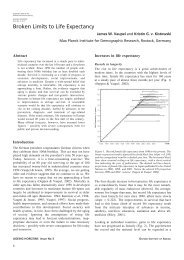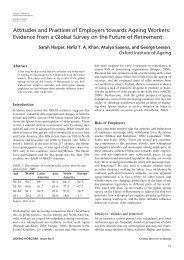Upskilling Older Workers by Ken Mayhew, Matt Elliott, and Bob Rijkers
Upskilling Older Workers by Ken Mayhew, Matt Elliott, and Bob Rijkers
Upskilling Older Workers by Ken Mayhew, Matt Elliott, and Bob Rijkers
You also want an ePaper? Increase the reach of your titles
YUMPU automatically turns print PDFs into web optimized ePapers that Google loves.
etween age 50 <strong>and</strong> 64 who left the activity guarantee<br />
between August 2000 <strong>and</strong> February 2002, only 741 got a<br />
regular job afterwards. The older unemployed also participate<br />
in a variety of labour market programmes that are open<br />
for all unemployed. However, pessimistic attitudes <strong>and</strong> the<br />
high incidence of long term unemployment suggest that<br />
“these general unemployment programmes only have had<br />
a limited impact on getting unemployed elderly back into<br />
jobs”. (OECD, 2003).<br />
Such evidence is consistent with the survey of the effect of<br />
labour market policy measures <strong>by</strong> Martin <strong>and</strong> Grubb (2001),<br />
who argue that training that is targeted <strong>and</strong> has a strong<br />
on-the-job element is most likely to be successful. This<br />
conclusion is echoed in the OECD 2006 report Living<br />
Longer Working Longer <strong>and</strong> evidence from the UK is also<br />
consistent with such claims. Work Based Learning for<br />
Adults (WBLA) programmes in Engl<strong>and</strong> <strong>and</strong> Scotl<strong>and</strong> have<br />
job-placement rates at approximately 27 per cent which are<br />
relatively constant across age groups. Such a success rate<br />
is not negligible, but not overly impressive either, especially<br />
if one recognizes that to evaluate the “true” success of such<br />
programmes, one would need to look at the success rate of<br />
a control group. The OECD concludes that where evidence<br />
is considered against a control group it is mixed (OECD,<br />
2006).<br />
Getting the Inactive back into Employment<br />
The role that training can play in getting the inactive back<br />
to work is hard to evaluate <strong>and</strong> there is little evidence. A<br />
particularly problematic feature is that, depending on the<br />
specific country circumstances, it can be hard, if not impossible,<br />
to force people in this category to train. The inactive<br />
who do train are the most likely to be enthusiastic <strong>and</strong> optimistic<br />
about their employment prospects. Thus a<br />
self-selection bias is lying in wait for any econometric evaluations.<br />
It seems that a significant proportion of the inactive are<br />
involuntarily so. Many studies indicate that workers who<br />
participate in training attach higher value to being employed<br />
<strong>and</strong> also have higher self-reported employment prospects.<br />
This suggests that training might be helpful in fostering positive<br />
attitudes among the inactive.<br />
Presuming that, on the whole, those in the labour market<br />
are generally more optimistic about their employment<br />
prospects than inactive workers, the low take-up of training<br />
grants <strong>by</strong> older unemployed workers in the UK, the<br />
Czech Republic <strong>and</strong> in Japan casts serious doubts on the<br />
efficacy of training for the inactive.<br />
Conclusions on the Ability of Training to Help<br />
Education <strong>and</strong> training are clearly importantly related to the<br />
labour market disadvantage of older workers. Those who<br />
received relatively little of it in their early years suffer<br />
most when they get older. There are various mechanisms<br />
accounting for this link, but whichever of these mechanisms<br />
dominates, the provision of education <strong>and</strong> training in<br />
later years is unlikely to be sufficient on its own. Whilst<br />
any single individual would be in less danger later in life<br />
if that individual were better educated or trained early in<br />
life, the key question is whether a Pareto improvement is<br />
possible, that is, whether a general increase in early education<br />
<strong>and</strong> training provision can increase total welfare. The<br />
answer to this question depends upon the dem<strong>and</strong> side as<br />
well as the supply side. In other words it depends upon the<br />
use (or lack of it) to which employers put skills – upon the<br />
nature of production processes <strong>and</strong> upon the consequent<br />
structure of jobs available (see, for example, Keep <strong>and</strong><br />
<strong>Mayhew</strong>, 2001). The OECD Report (2006) concludes that<br />
there is some evidence for “a dem<strong>and</strong> side problem, which<br />
needs to be addressed in combination with supply side problems”.<br />
6. Conclusions<br />
<strong>Older</strong> workers are disadvantaged in the labour market. They<br />
have substantially lower employment rates, suffer from<br />
greater long term unemployment, are less likely to make<br />
the transition out of inactivity, <strong>and</strong> often have to accept<br />
substantial reductions in their earnings when they find a new<br />
job. There are many causes of this disadvantage, several<br />
of which are driven or at least closely related to skill levels<br />
<strong>and</strong> lack of recent training. No one cause is able to explain<br />
all the stylised facts identified <strong>and</strong> it is clear that older<br />
workers suffer in the labour market for a complex interweave<br />
of reasons. At both the theoretical <strong>and</strong> empirical the<br />
case for training interventions is mixed at best. The task of<br />
empirically assessing the impact of training older workers<br />
is fraught with possible endogeneity issues <strong>and</strong> with the<br />
problem of poor proxies for the variables of interest.<br />
Providing older workers with additional skills will only<br />
make a difference if employers value them. Even where<br />
training subsidies do appear to improve their labour market<br />
outcomes, it is far from clear that the results are economically<br />
inefficient or justifiable on distributional grounds.<br />
What is clear is that, if the real problems lie on the dem<strong>and</strong><br />
side, improving the supply side will not help. Why, then,<br />
has there been so much emphasis on a largely unproven<br />
policy tool? Part of the answer must be that supply side<br />
interventions are easier than dem<strong>and</strong> side policies, which<br />
involve “interfering” with both social attitudes <strong>and</strong> with the<br />
product <strong>and</strong> production strategies of organisations. In this<br />
sense the importance accorded to human capital in addressing<br />
the problems of older workers is part of a larger<br />
tendency to over-play its role in tackling a broader range<br />
of economic <strong>and</strong> social problems.<br />
Acknowledgement<br />
This paper is an updated <strong>and</strong> abridged version of a paper produced<br />
<strong>by</strong> <strong>Mayhew</strong> <strong>and</strong> <strong>Rijkers</strong> for an OECD–European Commission<br />
workshop in December 2004. The original paper, How to improve<br />
the human capital of older workers or the sad tale of the magic<br />
bullet, can be found on the OECD website at<br />
http://www.oecd.org/dataoecd/3/39/34932028.pdf. We are grateful<br />
to the OECD for permission to use this material.<br />
AGEING HORIZONS Issue No 8<br />
OXFORD INSTITUTE OF AGEING<br />
19





![ORAL PRESENTATIONS [pdf] - Oxford Institute of Ageing](https://img.yumpu.com/37918222/1/184x260/oral-presentations-pdf-oxford-institute-of-ageing.jpg?quality=85)




